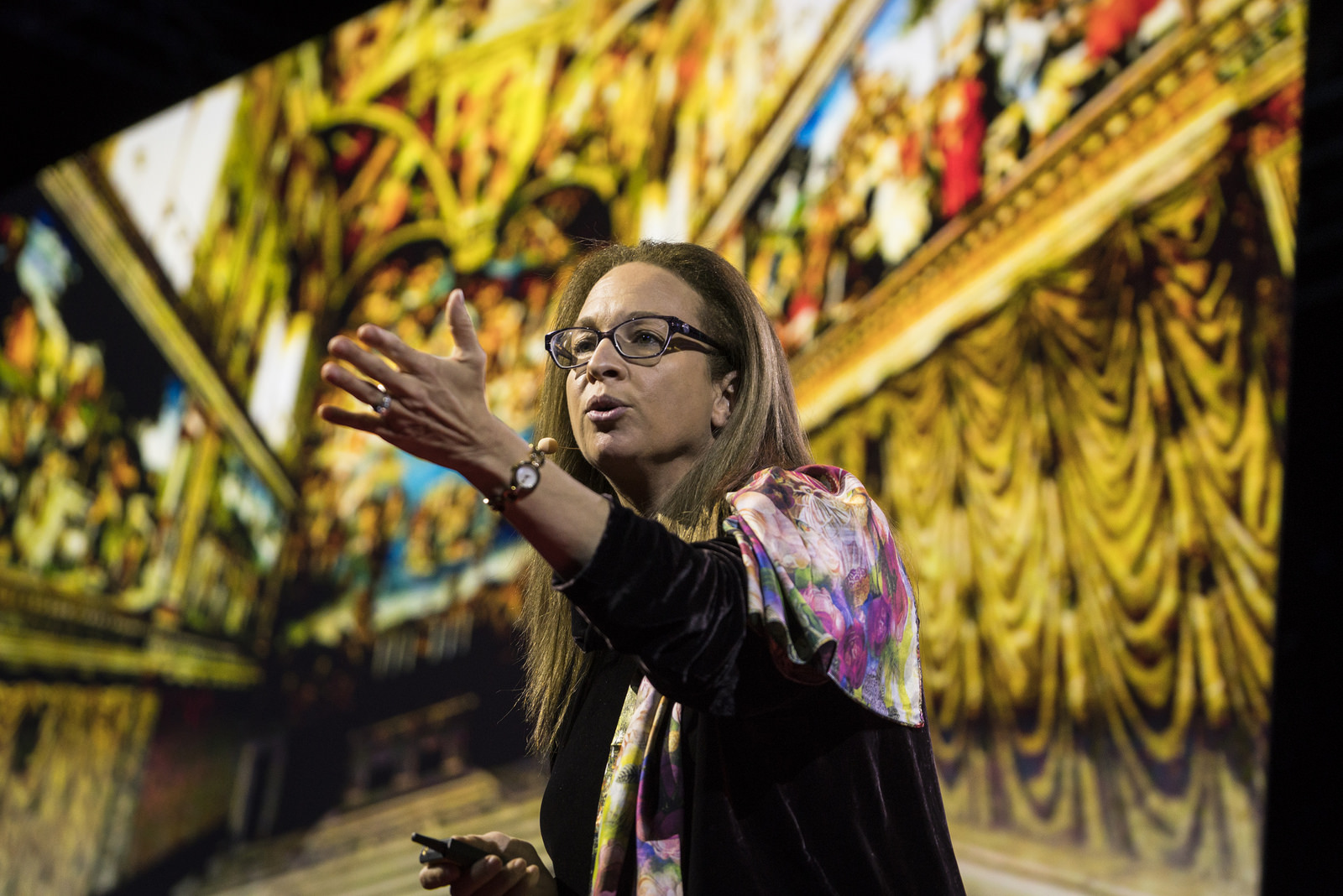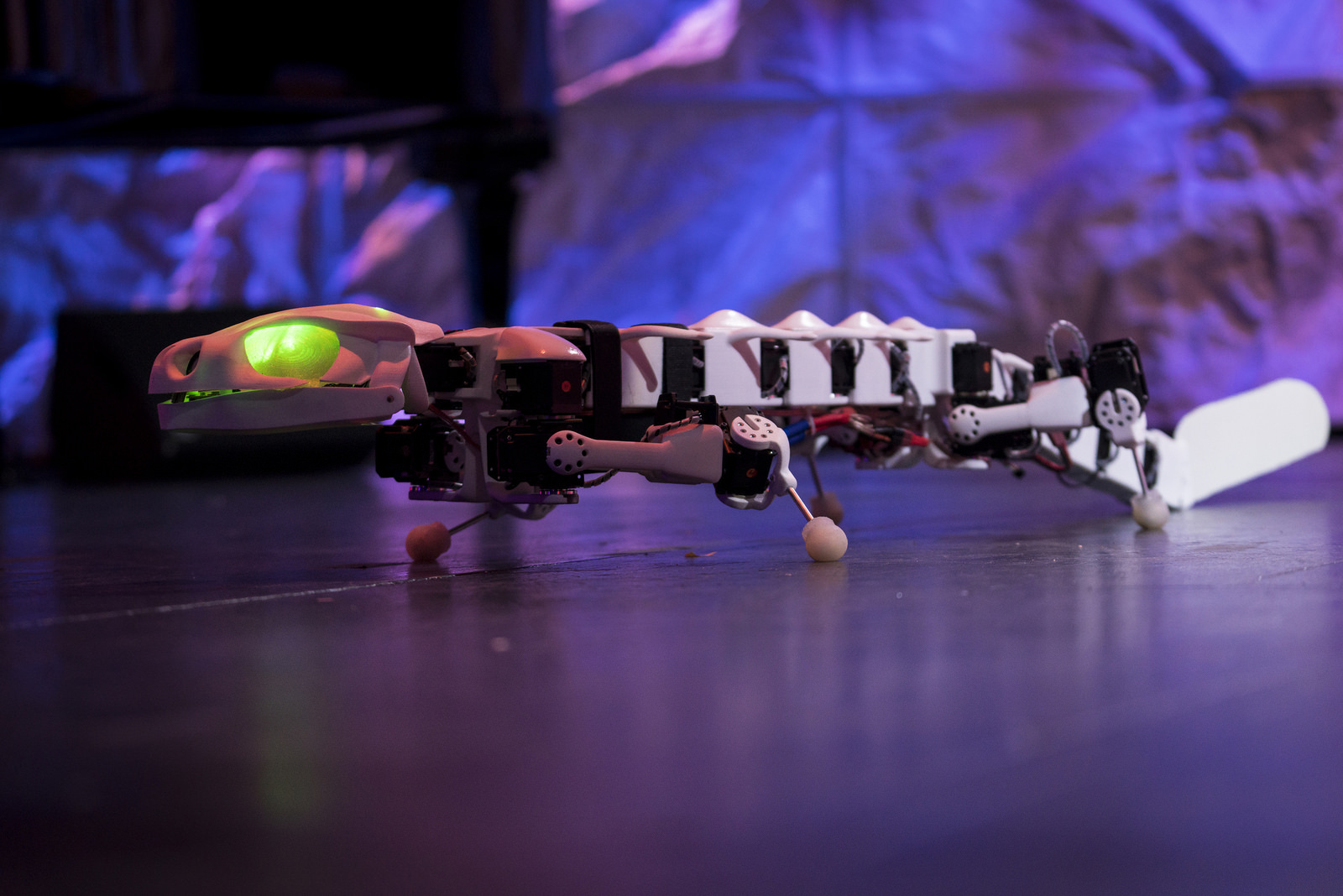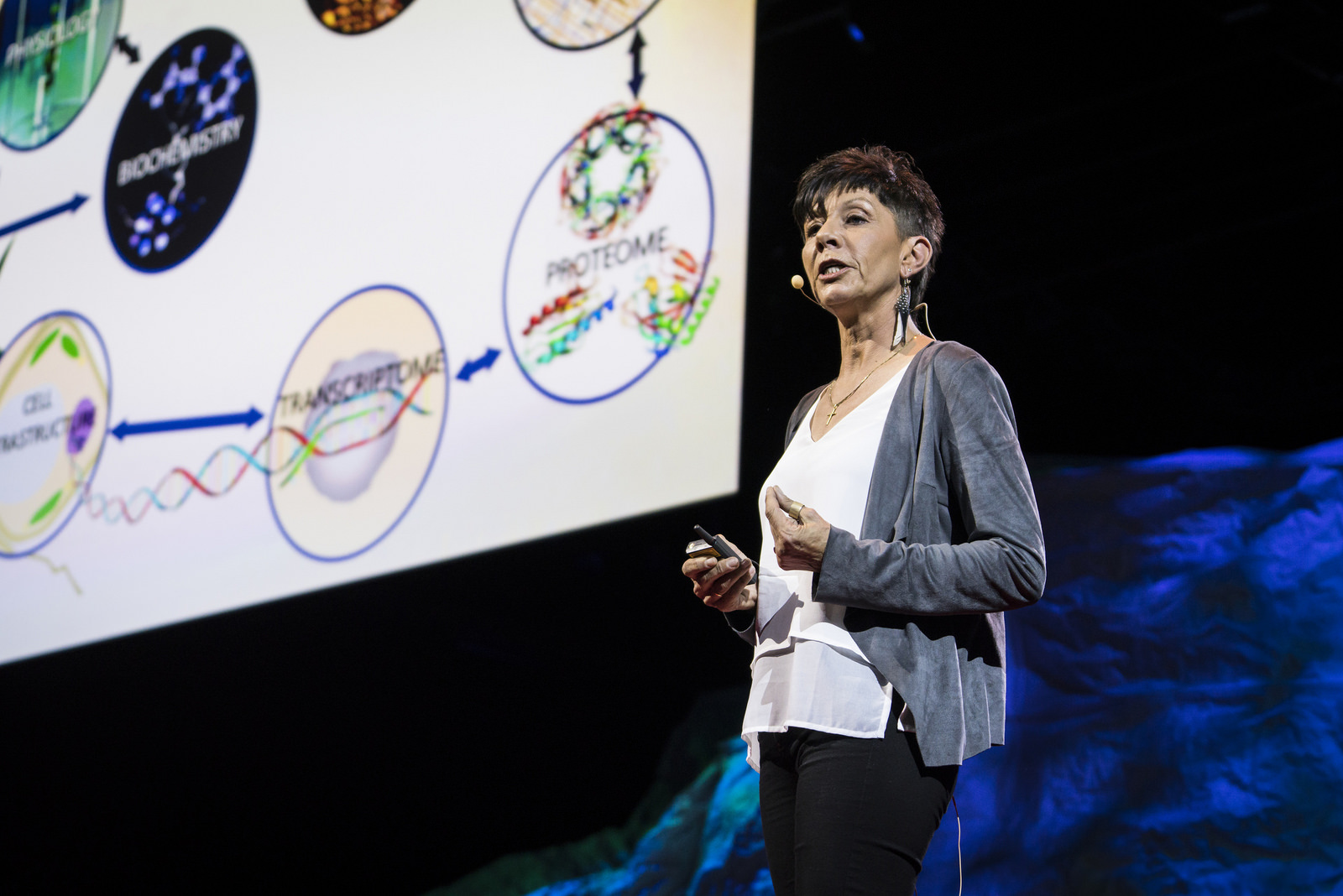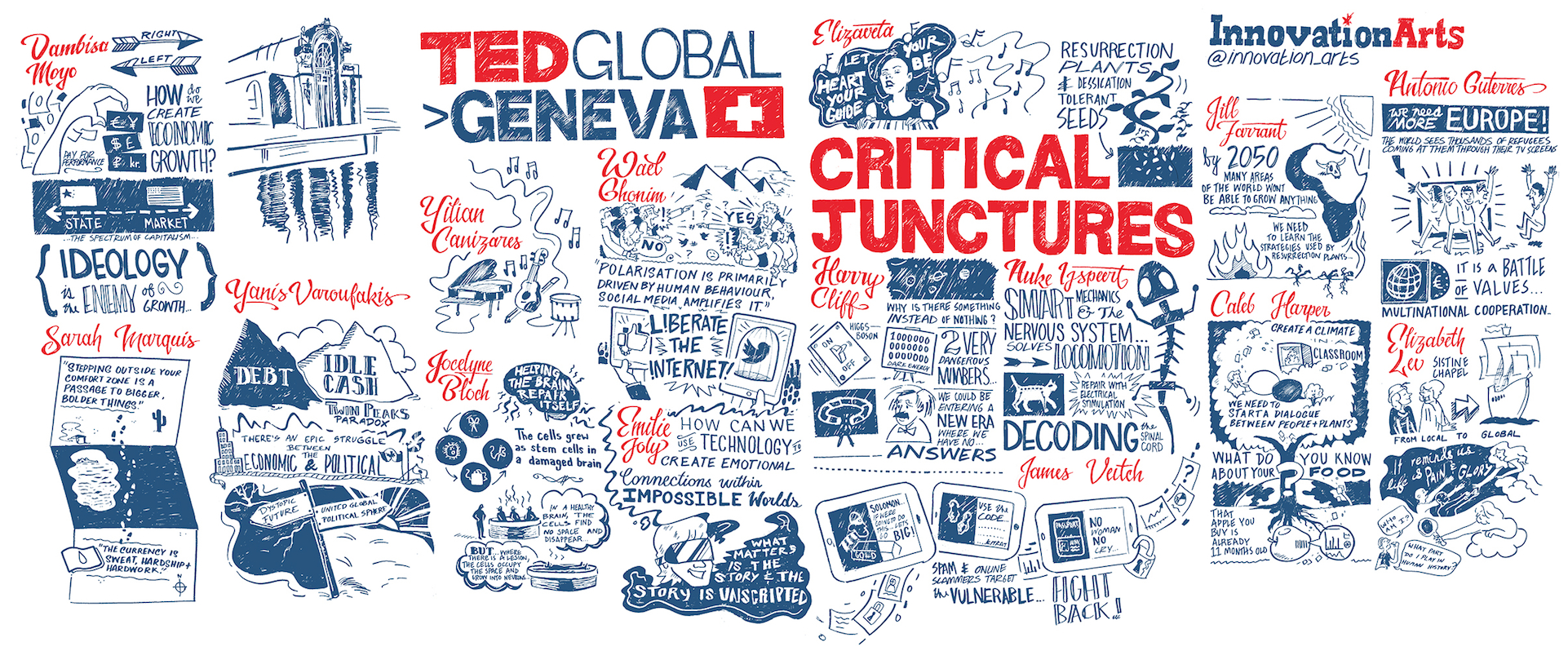
In a tour-de-force talk, Elizabeth Lev tours the ceiling of the Sistine Chapel during TEDGlobal>Geneva. Photo: James Duncan Davidson
Innovation happens at the critical junctures between success and failure, risk and reward, truth and daring, past and future. At TEDGlobal>Geneva, in a former power plant right in the middle of the Rhone river in downtown Geneva, the conference gathered 900 attendees from nearly 80 countries. Against a stage backdrop designed by the students of the Geneva School of Art and Design, 15 speakers and performers explored the newest thinking on everything from food to physics, economics and art history. Hosted by Bruno Giussani, TED’s European Director, on December 8, 2015, both sessions challenged the audience with surprising and insightful connections between what we know and what we hope to find. And during the breaks, drones flew in the building, robots walked around, VR headsets were available for trying, and a “serendipity door” art installation offered a glimpse into the Deep Web.
Among the attendees were 450 TEDx organizers from all over the world, who during the previous 48 hours held their own workshop at CERN and attended a special session on Peace Diplomacy, featuring researcher Achim Wennmann of the Geneva Graduate Institute and past TEDGlobal speaker Melissa Fleming of the UNHCR.
Below are highlights from each session of TEDGlobal>Geneva.
Session 1:
Why we need to rehabilitate growth. Economic growth is the defining challenge of our time, in both advanced and developing economies: Without it, political and social instability rises, human progress stagnates and societies grow dimmer. But according to global economist Dambisa Moyo, capitalism, what we think of as the main driver of economic growth, isn’t working. In both state-sponsored capitalism (like China) and market-driven models (like the United States), capitalism is failing to solve social ills, fostering corruption and creating income inequality. Her suggestion: We need to recognize that dogmatic, ideological economic doctrine doesn’t work, and we have to start thinking about capitalism as a spectrum — so we can blend the best of different capitalistic models together to foster growth. Watch Dambisa Moyo’s TED Talk >>
Bonus: Read a conversation between Dambisa Moyo and Yanis Varoufakis on ideas.ted.com >>
A better way to welcome refugees. In a Q&A, host Bruno Giussani sat down with António Guterres, the outgoing UN High Commissioner of Refugees, to discuss the complexities of today’s refugee crisis. Guterres suggests that much of Europe’s lack of preparedness stems from its own lack of solidarity on the issue. But with improved screening, shelter and distribution at entry points, Europe can learn to better welcome refugees, achieving both our humanitarian and our practical goals. Bigger picture: A multilateral turn toward acceptance will defy groups like ISIS’s anti-refugee propaganda and recruiting machine. Guterres also argued that Europe’s failure to integrate migrants in the past three decades has led to a disenfranchised second generation without hopes, and radicalizing. Guterres is ending his 10-year tenure as High Commissioner at the end of the year. Watch TED’s interview with António Guterres >>
Talking with each other instead of at each other. Back in 2011, Wael Ghonim said, “If you want to liberate a society, all you need is the Internet.” Today, he takes the stage to say: “I was wrong.” Ghonim is perhaps best known for his part in touching off the Arab Spring in his home of Egypt, by setting up a Facebook page that rallied Egyptians to protest. Social media back then, he says, was a place for young Arabs to escape frustrating political realities and imagine an alternative future. But once the revolution spilled onto the streets, the reality of hopeful revolution turned messy — then ugly and heartbreaking. What Ghonim wants us to understand is: social media followed suit. What was once a place for “crowdsourcing ideas, engaging people, and sharing news and information” became a polarized battleground. Just like, he suggests, most places where we try to have conversations on the web now. What can we do about it? Re-think platforms and incentivize civility and quality over loudness and quantity. Ghonim has founded a small social media startup, Parlio, to imagine an alternate social media space where civility is rewarded, and reasoned argument is prized. Watch Wael Ghonim’s TED Talk >>
A pop, opera, one-woman spectacular. In her second TEDGlobal appearance, musician Elizaveta begins with “Heroes,” a haunting, delicate mix of pop ballad and opera aria: “I can hear the drums and our horses run to the kingdom come through the pale moonlight / Our hearts ignite to the call.” Next, she sang “Space Pirate’s Love Song,” an upbeat ode to the universe, complete with stunning video footage of the earth from space: “Saturn’s rings and songs that sing / I know we are all made of stars / We are all cosmic dust / But we weren’t made to be alone.”
Cells that repair the brain. Through treating everything from strokes to car-accident traumas, neurosurgeon Jocelyne Bloch knows the brain’s unique inability to repair itself all too well. But now, she suggests, she and her colleagues may have found the key to neural repair: doublecortin-positive cells. Similar to stem cells, they are extremely adaptable and when extracted from a brain, cultured and then re-injected in a lesioned area of the same brain, can help repair and rebuild. “With a little help, the brain may be able to help itself.” Watch Jocelyn Bloch’s TED Talk >>

A salamander robot from Auke Ijspeert’s lab in Switzerland is helping us understand how animals move — and how to make better robots too. Photo: James Duncan Davidson
Robots to help understand biology. Roboticist Auke Ijspeert designs bio robots, machines modeled after real animals such as salamanders and cats. These robots take inspiration from animals so that they can handle complex terrain such as stairs and mountains, where robots have difficulty moving around. The process leads to better automata that can be used for field work, service, even search and rescue. But, perhaps more interestingly, the science of building bio robots is reflecting back on itself and unlocking previously unknown secrets of animal locomotion, and of the role and power of the spinal cord. Watch Auke Ijspeert’s TED Talk >>
An episodic world of VR. Designer Emilie Joly starts her talk by admitting a truth about virtual reality — it’s a little clunky. But in the next few years, as large headsets get easier to wear, she believe virtual reality will change the way we experience media — including the familiar episodic show. Onstage, she offers a first sneak peak at Sequenced, a new series from Apelab that explores the ability of virtual media to place the viewer in the scene, and change depending on what the viewer does. The live demo involves, basically, Emilie’s colleague Mike donning a bulky Oculus Rift headset and nodding his head around. As promised, he looks a bit silly. But what he’s seeing inside the headset is magical — a rich, manga-influenced world that exists all around him, with more than 50 triggers within a single scene that can react to where Mike wishes to go next. Sequenced will premiere at Sundance in January.
Questions physics can’t solve. The most frustrating mystery of the universe: Why is there something rather than nothing? According to particle physicist Harry Cliff, it’s not a lack of technology, but a lack of new laws of physics that could keep us from ever knowing. Cliff shares how even the law of relativity and string theory can’t fully explain mysteries such as the incredibly fine-tuned value of the Higgs Boson field or dark matter’s rapid expansion of the universe. Perhaps we are entering a new era, he continues, one with hints of a multiverse, but hardly any proof of it. Watch Harry Cliff’s TED Talk >>
Session 2:
A quarrel with capitalism. Have you wondered why politicians aren’t what they used to be? Yanis Varoufakis suggests that it’s because now, you can be in government today but not be in power — because power actually belongs to those who control the economy. He argues that the rich savers and corporations that control the economy are not interested (or downright terrified) to invest their more than $5 trillion in idle cash in productive ways that could invigorate the economy and tackle the mountains of debt that cripple many countries. His dream is for a world in which capital and labor no longer struggle against each other — “one that is simultaneously libertarian, Marxist and Keynesian,” with one global, digital currency, companies owned by workers and countries investing in green technology. In a Q&A with host Bruno Giussani, he also commented on his time, earlier this year, as Greece’s Finance Minister. Did he make mistakes? He laughs: “Every day!” Watch Yanis Varoufakis’ TED Talk >>

Jill Farrant studies “resurrection plants,” which can shrivel and dry up and then spring back to life. Could they hold the future of food in our hotter, dryer world? Photo: James Duncan Davidson
Resurrection plants. Plant seeds can last for years in a dried-up state; add water, and they grow into living plants. Molecular biologist Jill Farrant studies a much rarer phenomenon — actual plants that do the same thing, dry up to shrivelled gray inertia in drought times and then pop back to green life when rain falls. They’re called “resurrection plants,” they can survive extreme drought conditions, and there are only about 100 plant species in the whole world that can do this. In surprising time-lapse video, she shows exactly how fast these plants, from a fried-out dead-looking state, come back to life — and even flower. Could these super-resilient plants hold promise for growing more drought-resistant food in our coming hotter, drier world? Watch Jill Farrant’s TED Talk >>
Open source farming. Only 2 percent of Americans are actually involved in farming. How, then, do people make smart, engaged and empowered choices about the food we eat? Caleb Harper, director of CitiFARM at the MIT Media Lab, wants to democratize food production through open source technology that brings high-tech growing methods, like the NASA-pioneered aeroponics, to growers around the world. With these “food computers,” Harper and his team help people around the world to exchange plant data, so they can grow perfect vegetables in a climate-controlled space. Watch Caleb Harper’s TED Talk >>
Intrigued by spam. James Veitch responds to the spam emails you most likely delete. A few years ago, he responded to an email from a man who offered to cut him in on a deal involving a large quantity of gold. Email by email, Veitch narrated their months-long exchange, which included discussions of what they would do with their newfound wealth, a dubious set of code words and, of course, a request for Veitch to send some money.
An unauthorized history of the Sistine Chapel. It’s the Pope’s private chapel — yet it’s covered with paintings of nudes. In a tour-de-force talk, art historian Elizabeth Lev guides us across the ceiling of the Sistine Chapel and its vital depiction of the creation of Earth in the Christian tradition. The artist, Michelangelo, tells this story through massive, muscular and, yes, very naked figures, contrary to the sedate style of the day. Why so many nudes? Lev suggests an answer: to show the active ideas of the High Renaissance in very human form. Five hundred years later, says Lev, “The Sistine Chapel forces to look around as if it’s a mirror, and ask: who am I, and what role do I play in this great theater of life?” Watch Elizabeth Lev’s TED Talk >>
A journey around the world — by foot. Sarah Marquis didn’t become an explorer, she says, she was born one. In fact, Marquis, a National Geographic Explorer, walked a distance equivalent of the circumference of the world, then stopped counting. Chronicling her latest solo expedition into the inhospitable regions of Northern Australia, Marquis shares the deeper meaning of it all, “Surviving in those extreme places is like buying your ticket to freedom. The currency is sweat, hard work, determination.” It’s a humbling world, she says, that creates a “deep understanding of our invisible link to everything, everyone, everywhere.” Read our interview with Sarah Marquis on ideas.ted.com >>
A rainbow of sound. Yilian Cañizares blends jazz standards, classic music and Cuban rhythms to create a distinctive sound. Accompanied by a three-piece band on standing bass, piano and drums, the Swiss-Cuban musician closed out TEDGlobal>Geneva with two songs featuring catchy, rhythmic beats, soaring violin and gorgeous vocal work.

Yilian Cañizares fronts a Cuban / Swiss jazz combo, closing out TEDGlobal>Geneva with two songs evoking a lost nightclub … Photo: James Duncan Davidson

During TEDGlobal>Geneva, three graphic artists took “visual notes” of the whole conference: Eddie Jacob, James Huyton and Jordana Globerman, from InnovationArts in London, whose teams have similarly “scribed” many TEDGlobal conferences. They turned their notes into a visual map of all that was said on stage (image above, the bigger version can be downloaded here in PDF). They also created short experimental narratives about the economy (talks by Varoufakis and Moyo) and food (Harper and Farrant), which are available in PDF here.
Check out photos from the event on TED’s Flickr stream.
Comments (3)